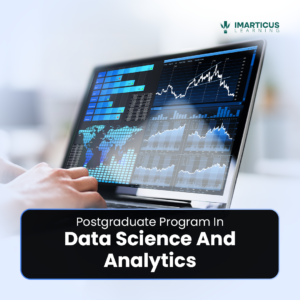What is Data Analytics?
“Data Analytics” is a crucial instrument for understanding and dealing with dynamic business trends. The role of data analytics is to act as a helping hand in giving clients or businesses personalised data-driven advice. A career in Data Analytics is a great lookout in today’s technologically advancing world because nothing can be accomplished without the use of data.
The evolution of Data Analytics has witnessed adaptation in various forms, gradually through the phases of technological advancement. It has offered multiple advantages to organisations and individuals involved in data analytics. Data Analytics is an ever-expanding discipline.
Become a Data Analyst
The field of data is one of the top-notch areas that is growing in the corporate world. It would be very profitable for individuals to have a career in data science, as technology is scaling every day. A data science course with placement can be a huge game changer when a young professional is trying to understand what is data analytics and looking to start a career in a related discipline.

History and evolution of Data Analytics
Read on to learn about the evolution of Data Analytics and how the four eras of analytics have grown over the years.
Relational and non-relational databases
Edgar F. Codd created relational databases in the 1970s, and they gained significant popularity in the 1980s. SQL queries were very famous at that point in time, and users used to derive data from several databases using RDBMS. Relational databases and SQL are still widely used and accepted, but technologies like MySQL are not that prevalent.
Relational databases like MySQL were intended to convert unstructured data and are typically highly strict. Soon, the internet had a surge in popularity, and the relational database couldn’t keep up. That is when NoSQL platforms like MongoDB were created to combat the shortcomings of RDBMS.
Business intelligence
Business Intelligence refers to the process of improving business trends and choices by seeking, aggregating, and evaluating the accumulated data preserved by an organisation. Power BI cannot be underestimated, as it was one of the most innovative and futuristic concepts in the 1990s.
Power BI is the ability to make decisions that are related to data technologies. Business intelligence was initially in the form of systematic consumer data but later took part in the decision-making process of large businesses.
Data visualisation
One can have a great career in Data Analytics if one understands the deep-rooted concepts of data visualisation. Visualisation means the representation of data in graphical form using representative tools like charts, graphs, diagrams, etc. With the evolution of data analytics in the big data era, the tools and technologies of data visualisation have been crucial for analysing a vast volume of data and making data-driven decisions.
The transition from Florence Nightingale’s diagram of mortality in the Army in the East to Tableau has been historical and remarkable. Florence Nightingale was a pioneer in the field of data visualisation who changed the ways of representing data for good. Such formats of statistical charts and graphs are now used in modern software like Tableau.
Big data
Big data emerged in early 2000 and Roger Magoulus first coined this term. The technology of big data emerged when handling immense amounts of data was not possible with only Power BI tools. Hadoop emerged as a big platform for processing large amounts of data.
The evolution of data analytics and big data in the four eras of analytics has become a very important part of the world of technology. It allowed the pooling of a large amount of data. The open-source platform gave its users the additional advantage of versatility. Many other open-source platforms developed after the success of big data, such as Apache Spark, Apache Cassandra, and so on.
Data Analytics in Cloud
Cloud computing tools and services have become more important as businesses have become more complex over time, allowing firms to stay up-to-date. The evolution of data analytics from traditional hardware to Cloud-based infrastructures is a good example.
In 1997, a famous professor, Ramnath Chellappa, defined Cloud Computing as a new type of computing paradigm where economic considerations dictate the ways of computing, only focusing on technical constraints.
Using Cloud and supporting programming technologies like Python, C++, Java, etc. has been most convenient for software professionals. The role of data analytics tools like Cloud is to offer more accessible storage and user facilities than ever before.
Applications of Data Analytics
Understanding the ways in which Data Analytics is used in the daily course of events is important. The fact is that Data Analytics is used in numerous business sectors. Some of the major applications of Data Analytics in multiple business sectors are enumerated as follows:
Manufacturing: Today, the manufacturing sector uses Data Analytics in its everyday operations. Data Analytics helps with supply chain management and solves complex supply chain problems. It also helps in resolving problems of labour shortages and looking out for any equipment breakdown.
Retail: It is mostly focused on tracking and understanding the buying patterns of customers. Data Analytics helps in analysing customer habits and tracking their patterns so that businesses can boost their sales by launching new products as per the taste and preferences of the customers.
Healthcare: by analysing the types of diseases, pharmaceutical drugs are created. The evolution of Data Analytics has helped to create novel medications and life-saving drugs for the treatment of patients. It results in better diagnosis and treatment of the patients.
Logistics: The main application of data analytics in logistics is to develop new business models. The industry is dynamic and requires changing models and techniques for effective results.
Education: The makers of the curriculum use data analytics to see the past results of the curriculum and the progress in the recent one. It allows policymakers to improve the learning process and inculcate essential skills in students that were missing earlier.
Banking: Banking is a complex process and requires the constant keeping of records. With the help of Data Analytics and its storage facility, it can be easily identified who the defaulters are in the banking system. It can help to better identify frauds and defaulters who have not paid the money they owe to the bank yet.
Conclusion
The evolution of Data Analytics has led to the rise of active fields in research and development today. Organisations are making a lot of investments in this area. If you want to learn data analytics and want to have a successful career, you can consider signing up for the Postgraduate Program in Data Science and Analytics at Imarticus.
A Data Analytics course and certification can always act as additional support other than your academic degree. It can showcase you as a more skilled person when compared to your contemporaries.
Companies must be well-versed in data analytics, including its various forms and applications, in order to fully benefit from these technologies. Some of the popular Data Analytics tools like, Python, Tableau, Qlik Sense, etc. have been vastly used by organisations in recent times.











